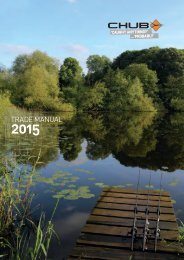CHAMPAGNE
This combination of weather influences makes for constant, moderate precipitation – a near-ideal pattern of rainfall that provides the vines with just enough water to produce quality fruit. Mean annual rainfall for the Champagne region as a whole is close to 700mm, ranging from 600mm to 900mm depending on the area.
This combination of weather influences makes for constant, moderate
precipitation – a near-ideal pattern of rainfall that provides the vines with just
enough water to produce quality fruit. Mean annual rainfall for the Champagne
region as a whole is close to 700mm, ranging from 600mm to 900mm depending
on the area.
You also want an ePaper? Increase the reach of your titles
YUMPU automatically turns print PDFs into web optimized ePapers that Google loves.
Bio-diversity and landscapes<br />
The region is home to numerous areas of special ecological<br />
interest, where bio-diversity is maintained by the conservation<br />
of natural habitats.<br />
The overall focus here is to improve the ecological infrastructure<br />
of the vineyard (cover cropping between vines and across slopes,<br />
and the establishment of hedgerows); also groundwater management<br />
on slopes, with an eye to solutions that fit harmoniously<br />
within the landscape.<br />
The accountable management of water,<br />
effluent, by-products and waste<br />
Water management<br />
Champagne producers use various methods to reduce<br />
their consumption of water. These include: the eco-design<br />
or eco-refurbishment of buildings; improved systems of<br />
cleaning, recycling and/or collection; and reducing water<br />
wastage wherever possible. Water conservation remains a<br />
priority, meanwhile maintaining high standards of hygiene in<br />
pressing centres, cuveries (units housing the fermenting vats)<br />
and other work premises.<br />
Management of effluent<br />
Cellar hygiene relies on frequent cleaning, which in turn generates<br />
effluent-borne organic matter.<br />
Today, 92 per cent of effluents and liquid by-products are treated or<br />
processed for recycling. The target for the future is 100 per cent.<br />
Waste and by-products<br />
All of the waste and by-products of Champagne wine and grape<br />
production are processed for recycling.<br />
The ‘marc’ (or pommace) is delivered to authorised distilleries<br />
where it is broken down by separation and extraction. A wide<br />
range of compounds are recovered for recycling: ethanol for<br />
industrial use and motor fuel; grape-seed oil; polyphenols,<br />
anti-oxidants and natural colour pigments; tartaric acid with<br />
potential application in processed foods, cosmetics and human<br />
health products.<br />
Activities linked to Champagne production also generate<br />
around 10,000 tonnes per year of industrial-type waste:<br />
metals, wood, glass and packaging materials including plastic,<br />
paper and board.<br />
Today, 75 per cent of this waste is sorted and processed for<br />
recycling, aiming for 100 per cent recovery in the near future.<br />
The energy and climate challenge<br />
This is probably the biggest challenge facing mankind in the<br />
years and decades to come – and one addressed by the Champagne<br />
region long before the passing of legislation. In early<br />
2003 the carbon footprint of the industry was assessed as a<br />
whole, launching the Champagne Climate Plan soon afterwards<br />
to demonstrate the solidarity with future generations.<br />
That Plan today encompasses five main focus areas, 16 research<br />
and development programmes and more than 40 individual projects<br />
either underway or in the pipeline. The main fields of action<br />
are: buildings/installations; viticultural and oenological practices;<br />
and freight transport and business travel (which relates to the<br />
responsible procurement of goods and services from sources as<br />
close as possible to the industry’s centres of supply).<br />
Sustainable<br />
viticulture<br />
15

















